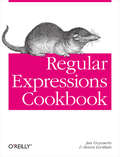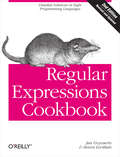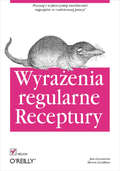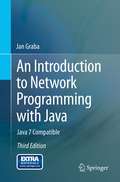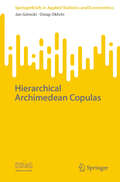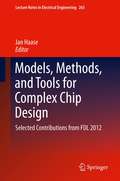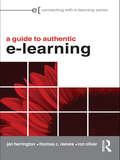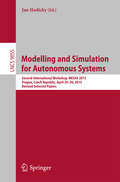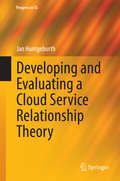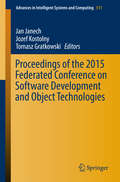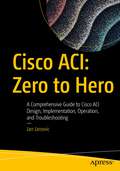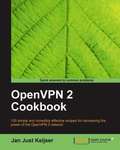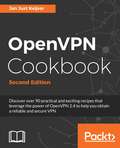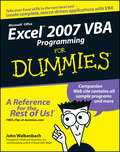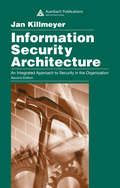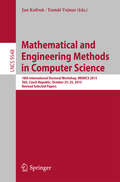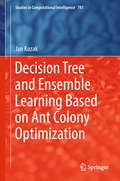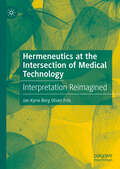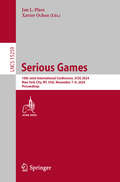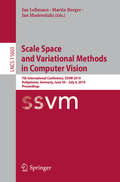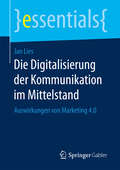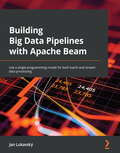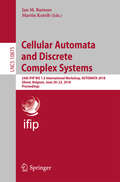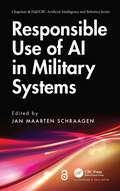- Table View
- List View
Regular Expressions Cookbook
by Steven Levithan Jan Goyvaerts<p>Take the guesswork out of using regular expressions. With more than 140 practical recipes, this cookbook provides everything you need to solve a wide range of real-world problems. Novices will learn basic skills and tools, and programmers and experienced users will find a wealth of detail. Each recipe provides samples you can use right away.</p>
Regular Expressions Cookbook: Detailed Solutions in Eight Programming Languages (Oreilly And Associate Ser.)
by Steven Levithan Jan GoyvaertsTake the guesswork out of using regular expressions. With more than 140 practical recipes, this cookbook provides everything you need to solve a wide range of real-world problems. Novices will learn basic skills and tools, and programmers and experienced users will find a wealth of detail. Each recipe provides samples you can use right away.This revised edition covers the regular expression flavors used by C#, Java, JavaScript, Perl, PHP, Python, Ruby, and VB.NET. You’ll learn powerful new tricks, avoid flavor-specific gotchas, and save valuable time with this huge library of practical solutions.Learn regular expressions basics through a detailed tutorialUse code listings to implement regular expressions with your language of choiceUnderstand how regular expressions differ from language to languageHandle common user input with recipes for validation and formattingFind and manipulate words, special characters, and lines of textDetect integers, floating-point numbers, and other numerical formatsParse source code and process log filesUse regular expressions in URLs, paths, and IP addressesManipulate HTML, XML, and data exchange formatsDiscover little-known regular expression tricks and techniques
Wyrażenia regularne. Receptury (in Polish)
by Steven Levithan Jan GoyvaertsWyraenie regularne (ang. regexp) to inaczej wzorzec, ktry okrela zbir dopasowanych acuchw znakw. Brzmi to prosto. Jednak przy pierwszym spotkaniu z wyraeniami wcale tak...
An Introduction to Network Programming with Java: Java 7 Compatible
by Jan GrabaSince the second edition of this text, the use of the Internet and networks generally has continued to expand at a phenomenal rate. This has led to both an increase in demand for network software and to improvements in the technology used to run such networks, with the latter naturally leading to changes in the former. During this time, the Java libraries have been updated to keep up with the new developments in network technology, so that the Java programming language continues to be one of the mainstays of network software development. In providing a very readable text that avoids getting immersed in low-level technical details, while still providing a useful, practical guide to network programming for both undergraduates and busy IT professionals, this third edition continues the trend of its predecessors. To retain its currency, the text has been updated to reflect changes that have taken place in Java's network technology over the past seven years (including the release of Java 7), whilst retaining its notable features of numerous code examples, screenshots and end-of-chapter exercises.
Hierarchical Archimedean Copulas (SpringerBriefs in Applied Statistics and Econometrics)
by Ostap Okhrin Jan GóreckiThis book offers a thorough understanding of Hierarchical Archimedean Copulas (HACs) and their practical applications. It covers the basics of copulas, explores the Archimedean family, and delves into the specifics of HACs, including their fundamental properties. The text also addresses sampling algorithms, HAC parameter estimation, and structure, and highlights temporal models with applications in finance and economics. The final chapter introduces R, MATLAB, and Octave toolboxes for copula modeling, enabling students, researchers, data scientists, and practitioners to model complex dependence structures and make well-informed decisions across various domains.
Models, Methods, and Tools for Complex Chip Design
by Jan HaaseThis book brings together a selection of the best papers from the fifteenth edition of the Forum on specification and Design Languages Conference (FDL), which was held in September 2012 at Vienna University of Technology, Vienna, Austria. FDL is a well-established international forum devoted to dissemination of research results, practical experiences and new ideas in the application of specification, design and verification languages to the design, modeling and verification of integrated circuits, complex hardware/software embedded systems, and mixed-technology systems.
A Guide to Authentic e-Learning (Connecting with E-learning)
by Thomas C. Reeves Jan Herrington Ron OliverPart of the groundbreaking Connecting with e-Learning series, A Guide to Authentic e-Learning provides effective, working examples to engage learners with authentic tasks in online settings. As technology continues to open up possibilities for innovative and effective teaching and learning opportunities, students and teachers are no longer content to accept familiar classroom or lecture-based pedagogies that rely on information delivery and little else. Situated and constructivist theories advocate that learning is best achieved in circumstances resembling the real-life application of knowledge. While there are multiple learning design models that share similar foundations, authentic e-learning tasks go beyond process to become complex, sustained activities that draw on realistic situations to produce realistic outcomes. A Guide to Authentic e-Learning: develops the conceptual framework for authentic learning tasks in online environments provides practical guidance on design, implementation, and evaluation of authentic e-learning tasks includes case studies and examples of outcomes of using authentic e-learning tasks Written for teaching professionals in Higher Education who teach online, A Guide to Authentic e-Learning offers concrete guidelines and examples for developing and implementing authentic e-learning tasks in ways that challenge students to maximize their learning. This essential book provides effective, working examples to engages learners with authentic tasks in online learning settings.
Modelling and Simulation for Autonomous Systems
by Jan HodickyThis book constitutes the thoroughly refereed post-workshop proceedings of the Second International Workshop on Modelling and Simulation for Autonomous Systems, MESAS 2015, held in Prague, Czech Republic, in April 2015. The 18 revised full papers included in the volume were carefully reviewed and selected from 33 submissions. They are organized in the following topical sections: state of the art and future of AS; MS experimental frameworks for AS; methods and algorithms for AS.
Developing and Evaluating a Cloud Service Relationship Theory
by Jan HuntgeburthThis book develops, evaluates and refines a cloud service relationship theory that explains how cloud users' uncertainties arise in these relationships and how they can be mitigated. To that end, the book employs principal-agent theory and the concepts of bounded rationality and social embeddedness. Beyond advancing IS research, the findings presented can greatly benefit governments, IT departments and IT providers, helping them to better understand cloud service relationships and to adjust their cloud service strategies accordingly.
Proceedings of the 2015 Federated Conference on Software Development and Object Technologies
by Jan Janech Jozef Kostolny Tomasz GratkowskiThis book presents the proceedings of the International Conference SDOT which was organized at the University in Žilina, Faculty of Management Sciences and Informatics, Slovak Republic in November 19, 2015. The conference was truly international both in terms of the amount of foreign contributions and in terms of composition of steering and scientific committees. The book and the conference serves as a platform of professional exchange of knowledge and experience for the latest trends in software development and object-oriented technologies (theory and practice). This proceedings present information on the latest developments and mediate the exchange of experience between practitioners and academia.
Cisco ACI: A Comprehensive Guide to Cisco ACI Design, Implementation, Operation, and Troubleshooting
by Jan JanovicIt doesn’t matter if you are completely new to Cisco ACI or you already have some experience with the technology, this book will guide you through the whole implementation lifecycle and provide you with a comprehensive toolset to become confident in any ACI-related task. In the beginning, it’s very important to build strong fundamental knowledge about Cisco ACI components. We'll go through underlay networking based on Nexus 9000 switches and describe the APIC controller cluster acting as the management plane of ACI. By building Access Policies, you'll see how to optimally connect servers, storage, routers, switches, or L4-L7 service devices to ACI. Then we'll properly design and implement Logical Application Policies. You will understand all the fabric forwarding behavior when using different ACI settings and architectures while getting a toolset on how to verify and troubleshoot eventual problems. This book also covers external L2 and L3 connectivity in ACI, more advanced features like integration with virtualization hypervisors and Kubernetes, service chaining of L4-L7 devices using Service Graphs, or practical approach to using REST API automation based on Python and Ansible/Terraform.Cisco ACI: Zero to Hero can additionally be used as a valuable source of theoretical and practical knowledge for all candidates preparing for CCIE DC v3.0 Written or Lab exams.What You'll LearnUnderstand network evolution and Cisco ACI components Underlay ACI networking based on Nexus 9000 switches, APIC controllers, and Application Policy ModelIntegrate ACI with virtualization hypervisors and KubernetesDynamically and seamlessly include L4-L7 service devices in communication between ACI endpoints Build ACI Anywhere: ACI Multi-Tier, Stretched Fabric, Multi-POD, Multi-Site, and Remote LeafUtilize ACI REST API with Python, related Cobra SDK, Ansible or Terraform, to develop automation and scripts on top of the ACI platformWho This Book Is ForNetwork engineers, architects, network developers, administrators or NOC technicians.
OpenVPN 2 Cookbook
by Jan Just KeijserThis is a cookbook, with practical recipes providing tips and tricks to the most common problems and scenarios faced with OpenVPN.This book is ideal for system administrators and networking professionals who are interested in building secure VPNs using OpenVPN. It is preferable that the reader has a basic knowledge of OpenVPN, as well as general network administration skills.
OpenVPN Cookbook - Second Edition
by Jan Just KeijserDiscover over 90 practical and exciting recipes that leverage the power of OpenVPN 2.4 to help you obtain a reliable and secure VPN About This Book • Master the skills of configuring, managing, and securing your VPN using the latest OpenVPN • Gain expertise in establishing IPv6 connections and understand PolarSSL using the latest version of OpenVPN • This book contains enticing recipes about OpenVPN functionalities that cater to mission critical applications Who This Book Is For This book is for system administrators who have a basic knowledge of OpenVPN and are eagerly waiting to build, secure, and manage VPNs using the latest version. This book assumes some prior knowledge of TCP/IP networking and OpenVPN and you must have network administration skills to get the most out of this book. What You Will Learn • Determine the best type of OpenVPN setup for your networking needs • Get to grips with the encryption, authentication, and certifications features of OpenSSL. • Integrate an OpenVPN server into the local IT infrastructure with the scripting features of OpenVPN • Ease the integration of Windows clients into the VPN using Windows-specific client-side configuration • Understand the authentication plugins for PAM and LDAP • Get to know the difference between TUN-style and TAP-style networks and when to use what • Troubleshoot your VPN setup • Establish a connection via IPv6 along with demonstrations In Detail OpenVPN provides an extensible VPN framework that has been designed to ease site-specific customization, such as providing the capability to distribute a customized installation package to clients, and supporting alternative authentication methods via OpenVPN's plugin module interface. This book provides you with many different recipes to help you set up, monitor, and troubleshoot an OpenVPN network. You will learn to configure a scalable, load-balanced VPN server farm that can handle thousands of dynamic connections from incoming VPN clients. You will also get to grips with the encryption, authentication, security, extensibility, and certifications features of OpenSSL. You will also get an understanding of IPv6 support and will get a demonstration of how to establish a connection via IPv64. This book will explore all the advanced features of OpenVPN and even some undocumented options, covering all the common network setups such as point-to-point networks and multi-client TUN-style and TAP-style networks. Finally, you will learn to manage, secure, and troubleshoot your virtual private networks using OpenVPN 2.4. Style and approach This practical, recipe-based book covers the core functionalities of OpenVPN ending with troubleshooting, performance tuning and making the readers inquisitive about the advanced features.
Excel 2007 VBA Programming For Dummies
by John Walkenbach Jan Karel PieterseStep-by-step instructions for creating VBA macrosHarness the power of VBA and create custom Excel applicationsMake Excel 2007 work for you! This clear, nonintimidating guide shows you how to use VBA to create Excel apps that look and work the way you want. Packed with plenty of sample programs, it explains how to work with range objects, control program flow, develop custom dialog boxes, create custom toolbars and menus, and much more.Discover how toGrasp essential programming conceptsUse the Visual Basic EditorNavigate the new Excel user interfaceCommunicate with your usersDeal with errors and bugs
Information Security Architecture: An Integrated Approach to Security in the Organization, Second Edition
by Jan KillmeyerInformation Security Architecture, Second Edition incorporates the knowledge developed during the past decade that has pushed the information security life cycle from infancy to a more mature, understandable, and manageable state. It simplifies security by providing clear and organized methods and by guiding you to the most effective resources avai
Mathematical and Engineering Methods in Computer Science
by Jan Kofroň Tomáš VojnarThis volume contains the post-conference proceedings of the 10th Doctoral Workshop on Mathematical and Engineering Methods in Computer Science, MEMICS 2015, held in Telč, Czech Republic, in October 2015. The 10 thoroughly revised full papers were carefully selected out of 25 submissions and are presented together with 3 invited papers. The topics covered include: security and safety, bioinformatics, recommender systems, high-performance and cloud computing, and non-traditional computational models (quantum computing, etc. ).
Debating Immigrants and Refugees in Central Europe: Politicising and Framing Newcomers in the Media and Political Arenas (Routledge/UACES Contemporary European Studies)
by Jan KovářThis book investigates the politicisation and framing of immigration in the media and political arena in Central Europe, examining two countries - Czechia and Slovakia - in the period surrounding the “European migrant crisis”. Following years of immigration being practically invisible as an issue in the socio-political debates in most Central and Eastern European countries, it became a key concern because of the crisis. Analyzing news media items and plenary speeches, this book reveals how securitisation eclipses humanitarian considerations, dominating the discourse around immigration and that media and politicians are the two most important intermediaries from which citizens take cues on issues they rarely experience directly themselves. Finally, it also shows how the media and political arena portray immigration differently based on the origin, religious background, and legal status of immigrants. This book will be of key interest to scholars and students of migration studies, global governance, international organisations, security studies, and media studies, as well as more broadly for public law, comparative politics and East/Central European politics.
Decision Tree and Ensemble Learning Based on Ant Colony Optimization (Studies in Computational Intelligence #781)
by Jan KozakThis book not only discusses the important topics in the area of machine learning and combinatorial optimization, it also combines them into one. This was decisive for choosing the material to be included in the book and determining its order of presentation. Decision trees are a popular method of classification as well as of knowledge representation. At the same time, they are easy to implement as the building blocks of an ensemble of classifiers. Admittedly, however, the task of constructing a near-optimal decision tree is a very complex process. The good results typically achieved by the ant colony optimization algorithms when dealing with combinatorial optimization problems suggest the possibility of also using that approach for effectively constructing decision trees. The underlying rationale is that both problem classes can be presented as graphs. This fact leads to option of considering a larger spectrum of solutions than those based on the heuristic. Moreover, ant colony optimization algorithms can be used to advantage when building ensembles of classifiers.This book is a combination of a research monograph and a textbook. It can be used in graduate courses, but is also of interest to researchers, both specialists in machine learning and those applying machine learning methods to cope with problems from any field of R&D.
Hermeneutics at the Intersection of Medical Technology: Interpretation Reimagined
by Jan Kyrre FriisThis book explores the crucial role of interpretation in medical radiology and beyond, emphasizing its pervasive influence on medical knowledge. Friis examines radiological analysis through hermeneutics, cognition, and visual perception studies. He argues that interpretation is inherently embodied and essential to human action, particularly in radiology, where technology extends vision beyond the human eye&’s limits. Yet, interpretation varies among radiologists. Can it be too relative, shaped by subjective factors irrelevant to the task? Attempts to eliminate cognitive bias through psychophysical and cognitivist approaches have failed. Interpretation is an active, context-dependent process, inseparable from human experience. Friis contends that the only solution is to expand cognitive reach through collaborative interpretative practices, integrating diverse perspectives. Radiology, like all medical fields, benefits from shared expertise, where multiple viewpoints refine diagnostic accuracy and mitigate individual bias. By fostering structured cooperation among radiologists, clinicians, interpretative reliability can be strengthened. The key is not to eliminate subjectivity but to harness it constructively through interdisciplinary dialogue, collective reasoning, and continuous knowledge exchange.
Serious Games: 10th Joint International Conference, JCSG 2024, New York City, NY, USA, November 7–8, 2024, Proceedings (Lecture Notes in Computer Science #15259)
by Jan L. Plass Xavier OchoaThis book constitutes the refereed proceedings of the 10th Joint International Conference on Serious Games, JCSG 2024, held in New York City, NY, USA, during November 7–8, 2024. The 19 full papers, 5 short papers, 12 posters and 5 demos included in this book were carefully reviewed and selected from 63 submissions. They were organized in topical sections as follows: Artificial intelligence in serious games; Serious games analytics; Serious game design; Impact studies; Extended realities; Healthcare and wellbeing; Applications.
Scale Space and Variational Methods in Computer Vision: 7th International Conference, SSVM 2019, Hofgeismar, Germany, June 30 – July 4, 2019, Proceedings (Lecture Notes in Computer Science #11603)
by Martin Burger Jan Lellmann Jan ModersitzkiThis book constitutes the proceedings of the 7th International Conference on Scale Space and Variational Methods in Computer Vision, SSVM 2019, held in Hofgeismar, Germany, in June/July 2019. The 44 papers included in this volume were carefully reviewed and selected for inclusion in this book. They were organized in topical sections named: 3D vision and feature analysis; inpainting, interpolation and compression; inverse problems in imaging; optimization methods in imaging; PDEs and level-set methods; registration and reconstruction; scale-space methods; segmentation and labeling; and variational methods.
Die Digitalisierung der Kommunikation im Mittelstand: Auswirkungen von Marketing 4.0 (essentials)
by Jan LiesDas essential thematisiert vier zentrale Entwicklungen, die die Praxis und Theorie von Marketing und Unternehmenskommunikation pr#65533;gen: Marketing 4. 0, Mittelstandskommunikation, Marketing-Mix und die Ann#65533;herung von Marketing und PR, wie sie beispielsweise bei Pok#65533;mon Go zu finden ist. Dabei geht es unter anderem um die Notwendigkeit des menschen-zentrierten Marketings und um die Relevanz der Unternehmenskommunikation f#65533;r den Mittelstand. Der Autor Jan Lies gibt Impulse f#65533;r kleine und mittelst#65533;ndische Unternehmen, sich mit den Potenzialen der Digitalisierung im Marketing auseinander zu setzen.
Building Big Data Pipelines with Apache Beam: Use a single programming model for both batch and stream data processing
by Jan LukavskyImplement, run, operate, and test data processing pipelines using Apache BeamKey FeaturesUnderstand how to improve usability and productivity when implementing Beam pipelinesLearn how to use stateful processing to implement complex use cases using Apache BeamImplement, test, and run Apache Beam pipelines with the help of expert tips and techniquesBook DescriptionApache Beam is an open source unified programming model for implementing and executing data processing pipelines, including Extract, Transform, and Load (ETL), batch, and stream processing.This book will help you to confidently build data processing pipelines with Apache Beam. You'll start with an overview of Apache Beam and understand how to use it to implement basic pipelines. You'll also learn how to test and run the pipelines efficiently. As you progress, you'll explore how to structure your code for reusability and also use various Domain Specific Languages (DSLs). Later chapters will show you how to use schemas and query your data using (streaming) SQL. Finally, you'll understand advanced Apache Beam concepts, such as implementing your own I/O connectors.By the end of this book, you'll have gained a deep understanding of the Apache Beam model and be able to apply it to solve problems.What you will learnUnderstand the core concepts and architecture of Apache BeamImplement stateless and stateful data processing pipelinesUse state and timers for processing real-time event processingStructure your code for reusabilityUse streaming SQL to process real-time data for increasing productivity and data accessibilityRun a pipeline using a portable runner and implement data processing using the Apache Beam Python SDKImplement Apache Beam I/O connectors using the Splittable DoFn APIWho this book is forThis book is for data engineers, data scientists, and data analysts who want to learn how Apache Beam works. Intermediate-level knowledge of the Java programming language is assumed.
Cellular Automata and Discrete Complex Systems: 24th IFIP WG 1.5 International Workshop, AUTOMATA 2018, Ghent, Belgium, June 20–22, 2018, Proceedings (Lecture Notes in Computer Science #10875)
by Jan M. Baetens Martin KutribThis volume constitutes the thoroughly refereed proceedings of the 24th IFIP WG 1.5 International Workshop on Cellular Automata and Discrete Complex Systems, AUTOMATA 2018, held in Ghent, Belgium, in June 2018.The 10 regular papers presented in this book were carefully reviewed and selected from a total of 16 submissions. The papers highlight the major advances in the field and the development of new tools, support the development of theory and applications of CA and DCS and identify and study within an inter- and multidisciplinary context, the important fundamental aspects, concepts, notions and problems concerning CA and DCS.
Responsible Use of AI in Military Systems (Chapman & Hall/CRC Artificial Intelligence and Robotics Series)
by Jan Maarten SchraagenArtificial Intelligence (AI) is widely used in society today. The (mis)use of biased data sets in machine learning applications is well‑known, resulting in discrimination and exclusion of citizens. Another example is the use of non‑transparent algorithms that can’t explain themselves to users, resulting in the AI not being trusted and therefore not being used when it might be beneficial to use it.Responsible Use of AI in Military Systems lays out what is required to develop and use AI in military systems in a responsible manner. Current developments in the emerging field of Responsible AI as applied to military systems in general (not merely weapons systems) are discussed. The book takes a broad and transdisciplinary scope by including contributions from the fields of philosophy, law, human factors, AI, systems engineering, and policy development.Divided into five sections, Section I covers various practical models and approaches to implementing military AI responsibly; Section II focuses on liability and accountability of individuals and states; Section III deals with human control in human‑AI military teams; Section IV addresses policy aspects such as multilateral security negotiations; and Section V focuses on ‘autonomy’ and ‘meaningful human control’ in weapons systems.Key Features: Takes a broad transdisciplinary approach to responsible AI Examines military systems in the broad sense of the word Focuses on the practical development and use of responsible AI Presents a coherent set of chapters, as all authors spent two days discussing each other’s work This book provides the reader with a broad overview of all relevant aspects involved with the responsible development, deployment and use of AI in military systems. It stresses both the advantages of AI as well as the potential downsides of including AI in military systems.
